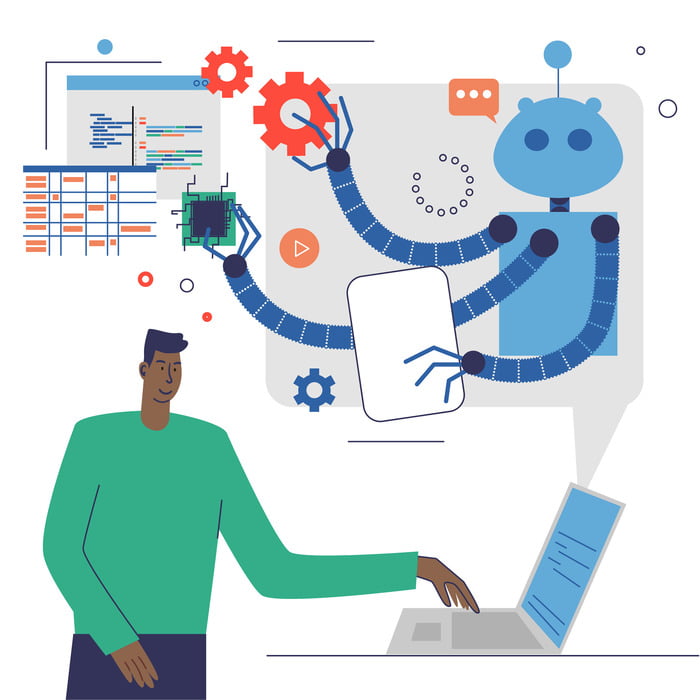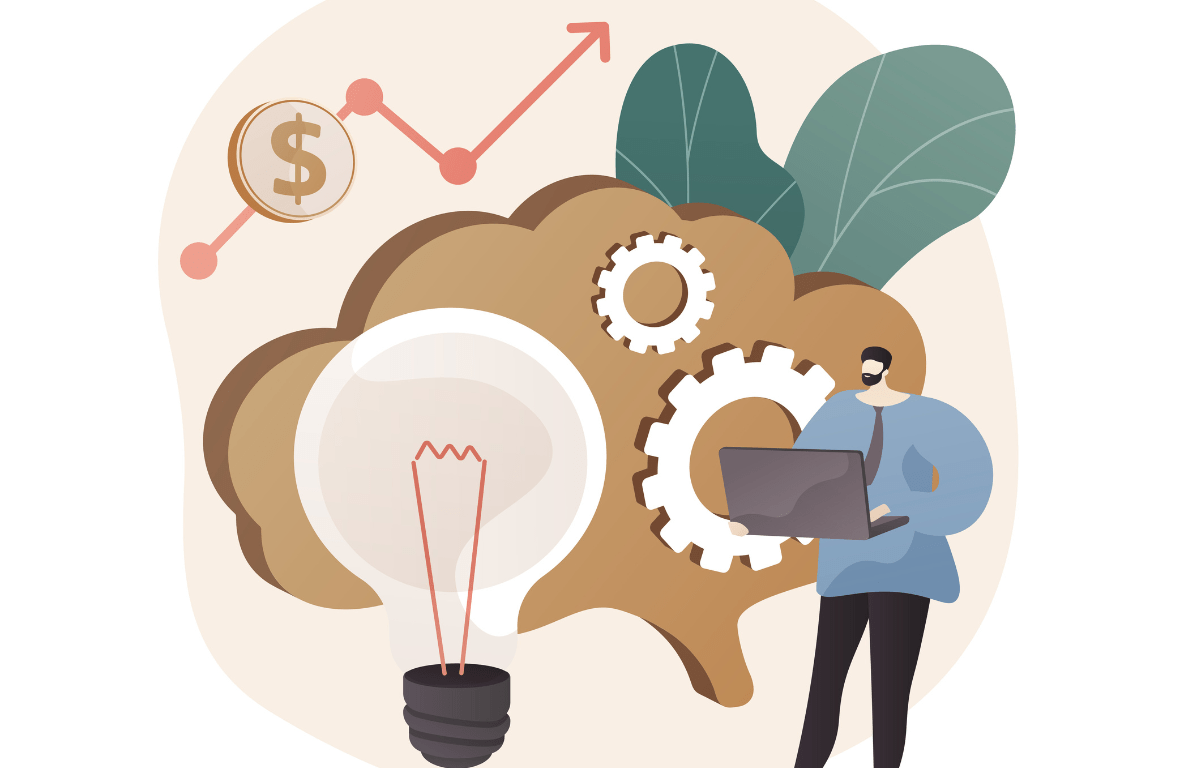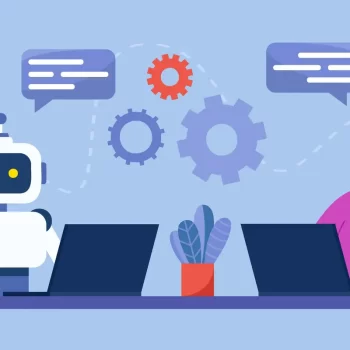Whether you’re a startup founder, a CTO, or a growth-oriented business operator, you need to have end-to-end visibility across your services and network. Otherwise, your ITOps teams might encounter a data center breakdown, printer failure, a blank computer screen, and many other issues.
According to the research report by Ponemon, the average cost of an unplanned data center failure was £6,850 per minute. The fact is that modern IT teams must continually analyze an enormous amount of data and employ numerous tools that track data. This results in long delays in problem identification and resolution. Also, a single outage can result in a huge number of alerts, logs, and events. In a complex IT infrastructure that consists of multiple distinctive apps and databases, a heavy reliance on human processes can significantly hinder the effectiveness of business operations.
That’s why many businesses are turning towards Generative AI to resolve high-impact IT operations problems.
Related blog: 4 Real-World Tips to Optimize the Productivity of Your Modern IT Teams
What is Generative AI?

Generative AI refers to the application of artificial intelligence techniques that have the capacity to autonomously produce new, original content or data. Unlike traditional AI models that rely on predefined rules and patterns, generative models possess the ability to generate outputs that have not been explicitly programmed.
Additionally, Generative AI can be applied to tasks such as automated documentation creation, where it can generate technical documents, user guides, and reports, saving significant time and effort for IT professionals. By learning patterns from historical data, it can identify, and flag anomalies or potential security breaches, allowing for swift responses and mitigation measures. This technology is proving to be a powerful tool in optimizing IT operations, fostering innovation, and driving efficiency across a spectrum of tasks, from development to maintenance and beyond.
Generative AI: A Game-Changer for ITOps Teams and Management
Generative AI is reshaping the world of IT operations by enabling proactive and intelligent incident management for businesses. By analyzing massive amounts of data, providing insightful analysis, and acting as a smart assistant, Generative AI empowers IT professionals, streamlines procedures, and boosts team productivity. Other than that, it shows incredible promise, particularly when it comes to explaining complex subjects in Natural Language. But can AI help ITOps teams that are struggling to keep up with the flood of incidents that demand their attention? Of course, yes!
Within IT operations, Generative AI quickly analyzes incidents, identifies patterns, and provides real-time summaries and root cause analysis. This eliminates the need for continuous data analytics checks, instead of delivering predictive notifications for root cause analysis. This enables your IT operations team to examine activity logs, events, and incident traces to understand upcoming outages. By conducting root cause analysis of performance issues, you can anticipate future incidents and better prepare to mitigate IT risks.
How Generative AI Can Accelerate ITOps Team Performance?

With the shift towards a hybrid work environment, conventional IT operations are proving to be less effective in supporting employees in their tasks. Conversely, as serverless architectures and microservice-driven applications gain prominence, the conventional IT infrastructure struggles to meet the intricate demands of today’s IT service delivery. It falls short of delivering the necessary data analytics and insights to optimize services and achieve immediate business results.
This necessitates the integration of AI or more advanced machine learning data models to predict events and mitigate their impact before they escalate into significant challenges for enterprise leaders. By incorporating artificial intelligence into ITOps, you can gain the ability to promptly identify anomalies and avert IT failures.
Let’s delve into how Generative AI can accelerate the ITOps team’s performance by automating routine tasks and expediting complex processes.
Faster Problem Resolution
Generative AI plays a pivotal role in expediting problem resolution within IT operations. These models provide invaluable assistance when it comes to code generation and debugging. By offering suggestions, generating code snippets, or even automatically fixing common errors, Generative AI drastically accelerates the process of identifying and rectifying software bugs or issues. This rapid response is particularly critical in dynamic environments where downtime or glitches can have significant consequences. Consequently, ITOps teams experience a notable reduction in system downtime and a corresponding boost in operational continuity.
Furthermore, the ability of generative models to assist in debugging extends beyond mere efficiency. It also empowers IT professionals to tackle more complex challenges with confidence. By automating the initial stages of problem-solving, these models free up valuable time and mental bandwidth for IT experts to focus on higher-level strategic initiatives, research, and development. This results in a more agile and adaptive IT ecosystem capable of addressing evolving challenges and opportunities with greater agility.
Enhanced Productivity
Generative AI transforms IT operations by automating a wide array of tasks, ranging from documentation creation to log analysis. This means that ITOps teams can accomplish more within the same time frame, leading to increased overall productivity. For instance, generative models can swiftly process and extract relevant information instead of spending hours manually generating reports or sifting through extensive logs.
This not only saves time but also ensures that IT professionals can focus their expertise on more strategic and value-driven activities.
Moreover, the productivity gains from employing Generative AI extend to resource utilization. By predicting resource requirements based on historical data and patterns, ITOps teams can make informed decisions about resource allocation. This leads to a more efficient use of computing power, storage, and network resources. As a result, organizations can optimize their IT infrastructure, achieving cost savings while maintaining high-performance levels. This enhanced resource efficiency ultimately translates into a more competitive and agile IT environment.
Proactive Maintenance
Generative AI equips ITOps teams with the ability to foresee potential hardware or software failures. These models enable proactive maintenance efforts by analyzing historical data and identifying patterns indicative of impending issues.

This means that components can be replaced or upgraded before they fail, minimizing downtime and disruptions. As a result, organizations experience improved system reliability and operational continuity, which are primary factors in maintaining a seamless and responsive IT environment.
The predictive capabilities of Generative AI have a significant impact on cost savings. Organizations can avoid the costly consequences of unexpected downtime by addressing issues before they escalate into critical failures. This reduces immediate financial losses and safeguards the organization’s reputation and customer trust.
More Accurate Anomaly Detection
Generative AI excels in recognizing patterns and identifying anomalies within data sets. This capability is a game-changer for ITOps teams tasked with safeguarding system integrity and security. By continuously monitoring and analyzing data, generative models can swiftly detect any deviations from expected behavior. This means that potential security breaches or performance issues are identified early, allowing ITOps teams to respond promptly and effectively. This level of vigilance is crucial in today’s rapidly evolving threat landscape, where quick detection and mitigation can make all the difference in minimizing the impact of security incidents.
The accuracy and reliability of Generative AI in anomaly detection translate to reduced false positives. This means that ITOps teams can focus their attention and resources on genuine threats rather than wasting time on false alarms. This not only streamlines incident response but also allows for a more targeted and right approach to managing security risks.
Enhanced Security Measures
Generative AI contributes significantly to the overall security posture of IT operations. By analyzing patterns associated with security threats, these models empower ITOps teams to develop and implement more streamlined security policies and measures. This includes measures such as access controls, encryption protocols, and threat detection mechanisms.
By leveraging Generative AI, ITOps teams can stay ahead of evolving security threats and ensure that their systems are fortified against potential breaches.
Also, ITOps teams can use this AI model to simulate various attack scenarios and test the effectiveness of their security measures. This allows for the identification of vulnerabilities and the implementation of proactive countermeasures. By proactively addressing potential security weaknesses, organizations can significantly reduce the likelihood and impact of successful cyberattacks.
Improved Customer Service

Generative AI-powered chatbots are invaluable tools for enhancing customer service within IT operations. These chatbots can provide rapid and accurate responses to user queries, leading to improved customer satisfaction. By automating responses to common inquiries, ITOps teams can free up time for more complex and specialized tasks. This means that users receive timely assistance, leading to higher levels of user satisfaction and a more positive overall experience.
Moreover, Generative AI-powered chatbots have the potential to operate around the clock, providing continuous support to users regardless of time zones or working hours. This ensures that users can receive assistance whenever they need it, contributing to a more seamless and responsive IT service delivery.
Optimized Network Performance
Generative AI’s ability to analyze network traffic patterns provides valuable insights for ITOps teams seeking to optimize network performance. By identifying optimal network configurations, ITOps professionals can make data-driven decisions to enhance network efficiency. This leads to improved data transmission speeds, reduced latency, and overall better performance of network services.
Furthermore, the optimization of network performance through Generative AI can result in cost savings. By maximizing the efficiency of network resources, organizations can potentially reduce expenses associated with network infrastructure and bandwidth. This leads to a more cost-effective IT environment without compromising on performance.
Key Use Cases of Generative AI in ITOps
Generative AI acts as a smart assistant for ITOps teams, which can greatly reduce stress and improve incident response. According to the Big Panda survey, it can reduce response times by up to 10 minutes for each incident. Also, it provides IT teams with a second pair of eyes, equivalent to having a full-stack engineer instantly accessible for any queries. Here are some prominent use cases of Generative AI in ITOps management:
Automated Incident Response

Generative AI plays a crucial role in automating incident response within ITOps. When an incident is reported, the AI system can quickly analyze the details, including logs, error messages, and historical incident data. It then generates suggested actions or resolutions based on patterns and prior successful responses. This not only accelerates incident resolution but also ensures consistent and best-practice-driven responses. ITOps teams can focus on more complex issues, knowing that routine incidents are effectively handled.
Also, Generative AI can provide real-time updates to incident stakeholders, ensuring transparency and clear communication throughout the resolution process. This results in reduced downtime, improved customer satisfaction, and enhanced service reliability.
Predictive Maintenance
Predictive maintenance powered by Generative AI transforms ITOps by proactively addressing hardware failures. The AI system continually monitors the performance and health of hardware components, such as servers, storage devices, and networking equipment. By analyzing historical data, it can predict when these components are likely to fail, allowing ITOps teams to schedule maintenance or replacements during planned maintenance windows. This not only prevents unexpected outages but also extends the lifespan of hardware, resulting in cost savings.
Furthermore, predictive maintenance reduces the need for constant manual monitoring, freeing up IT professionals to focus on strategic tasks. It also supports data-driven decision-making regarding hardware investments and upgrades, ensuring that resources are allocated in the right way and aligned with objectives.
Automated Troubleshooting
Generative AI is a valuable tool for ITOps when it comes to troubleshooting technical issues. It can ingest large volumes of logs, events, and performance metrics from various systems and applications. Using machine learning algorithms, the AI system can identify patterns and anomalies that might be missed by human operators. Once an issue is detected, it can generate detailed troubleshooting steps, including recommendations for system checks, configuration adjustments, or software updates. This speeds up issue resolution and ensures that IT professionals follow a standardized and effective troubleshooting process.
Moreover, Generative AI can maintain a repository of past troubleshooting cases and their resolutions. This knowledge base can be continuously updated and used as a reference for IT staff, improving their problem-solving capabilities and reducing the reliance on tribal knowledge within the organization.
Natural Language Interaction
Generative AI’s natural language processing capabilities enable it to act as an interface between technical IT teams and non-technical stakeholders. It allows business users, executives, or customers to communicate with IT systems using plain language, making it easier to request assistance, report issues, or seek information. For example, a business leader could ask, “How can we improve system performance?” and the AI system can generate a response with recommendations for optimizing resources based on historical data and best practices.
Furthermore, this natural language interaction extends to IT support chatbots that can provide immediate assistance 24/7. Users can ask questions, report problems, or request help with common IT tasks such as password resets or software installations. This not only enhances user satisfaction but also reduces the workload on IT support teams.
Automated Log Analysis
With the help of Generative AI, you can analyze historical and current log data to create artificial logs that replicate real-world patterns. By integrating these synthetic logs with authentic ones, systems powered by Generative AI can heighten their capacity to discern irregularities, identify emerging trends, and predict potential issues.
For instance, if the genuine logs display a sudden surge in error entries while the synthetic logs do not mirror this pattern, it may indicate a specific problem or anomaly that necessitates immediate attention. Through the utilization of Generative AI, automated log analysis systems can promptly notify the IT team, enabling them to investigate and rectify the issue before it adversely affects user experience or leads to system downtime.
Automated Knowledge Base Generation

Generative AI assists ITOps teams by automatically generating documentation, FAQs, and best practices. It can analyze existing data, documentation, and expert knowledge to create and maintain a comprehensive knowledge base. This knowledge base is continuously updated with the latest information, ensuring that IT professionals have easy access to relevant documentation and resources.
When new systems or processes are implemented, the AI system can generate documentation and FAQs to facilitate onboarding and training.
Moreover, the AI-driven knowledge base can support self-service IT support, allowing users to find answers to common questions and troubleshoot basic issues on their own. This reduces the volume of support tickets and enables IT teams to focus on more complex and critical tasks.
Capacity Planning and Resource Optimization
Generative AI aids in capacity planning and resource optimization by analyzing historical performance data and workload trends. It can provide recommendations on how to allocate resources such as CPU, memory, and storage to ensure optimal performance. For example, during periods of high demand, the AI system may suggest scaling resources up to meet the increased workload. Conversely, during periods of lower demand, it may recommend scaling down to save on operational costs. This dynamic resource allocation ensures that resources are utilized correctly and aligned with business needs.
Dynamic Resource Scaling
Dynamic resource scaling is a crucial aspect of managing modern IT environments. With the help of Generative AI, you can continuously monitor real-time workload demands and adjust resource allocations accordingly. For instance, during a sudden surge in website traffic, the AI system can automatically provision additional server instances to handle the increased load. Conversely, during periods of low demand, it can scale down resources to conserve energy and reduce costs.
Security Analysis and Anomaly Detection

Generative AI enhances security operations within ITOps by analyzing logs, network traffic, and system behavior to detect anomalies and potential security breaches. It leverages machine learning algorithms to identify suspicious patterns that may indicate unauthorized access, malware activity, or other security threats. When anomalies are detected, the AI system generates alerts and recommendations for further investigation and mitigation.
Additionally, Generative AI can contribute to threat intelligence by continuously learning from new data and adapting to emerging threats. It helps IT teams stay ahead of evolving cybersecurity risks and bolsters the overall security posture of the organization.
Automated Patch Management
Automated patch management reduces the risk of vulnerabilities and security breaches caused by outdated software. It also helps IT teams maintain compliance with industry regulations and internal security policies, providing a more secure IT environment for the organization.
Generative AI automates the process of identifying, testing, and applying software patches and updates. It analyzes available patches, evaluates their compatibility with existing systems, and generates a prioritized list of patches to be applied. This ensures that systems are consistently up-to-date with the latest security, performance, and feature enhancements.
Workflow Automation
Generative AI plays a crucial role in streamlining IT operations by taking over routine tasks and workflows. This includes handling tasks such as automated backups, making necessary configuration changes, and managing software deployments. This automation reduces the need for manual intervention, which, in turn, minimizes the potential for human errors. Tasks are executed consistently and reliably, ensuring operational stability.
Beyond the immediate benefits of task automation, this technology enables IT teams to reallocate their time and expertise to more strategic initiatives. This can lead to a boost in overall efficiency and innovation within IT operations.
Event Correlation and Noise Reduction
In the fast-paced world of IT, even minor incidents can trigger thousands of alerts, tickets, and events. According to a report from AIOps Exchange, a significant 40% of organizations are flooded with over 1 million alerts per day. Here, AI proves invaluable by identifying temporal associations, discovering correlated logs, and grouping events into a more manageable set of logical categories. This noise reduction provides significant relief to IT staff. They can now focus on a select few critical incidents instead of being inundated by a continuous stream of less important events.
How Infraon Helps You Leverage Generative AI for ITOps?

Infraon helps you automate your ITOps requests and provides the self-service capability for real-time resolutions. It integrates Generative AI with conversational AI chatbots to enhance IT support functionalities. Natural language processing, facilitates seamless interactions, while optimized resource allocation ensures streamlined utilization of IT resources. Infraon’s Generative AI continually learns and adapts, providing customized recommendations based on real-time insights, ultimately enhancing the agility and effectiveness of IT operations.
Infraon delivers real-time insights and reporting by seamlessly integrating Generative AI, offering a comprehensive view of IT infrastructure performance. This empowers IT teams to make informed decisions, driving better outcomes for the organization.
Related blog: Everything You Should Know About Collaborative Work Management In 2023
Final Note
So, if you’re ready to start using generative AI, make sure your vendor offers security and data best practices, analytics with visibility into impact and potential root causes, and a wide range of tools for quick, accurate, and reliable incident analysis. With more businesses embracing the power of generative AI, we can anticipate even more cutting-edge use cases to emerge and further transform the IT industry.
















